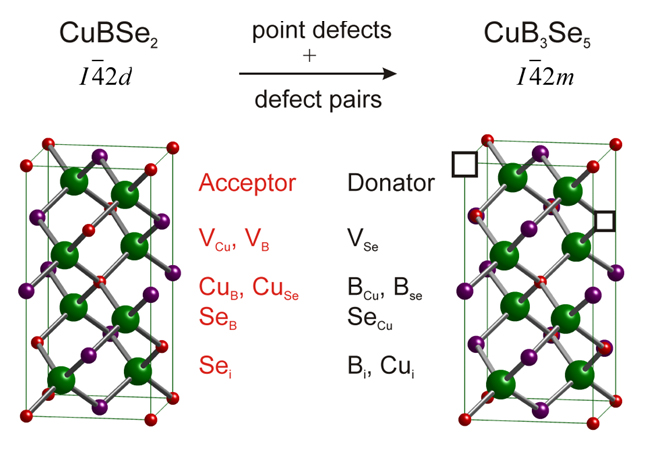Department Structure and Dynamics of Energy Materials
Point defect analysis of Cu(In,Ga)X2 chalcopyrite materials

Formation of the vacancy phase CuIn3Se5 by the
clustering of defects in Cu-poor CuInSe2 (B=In, Ga).
Presented at the E-MRS Spring Meeting 2012 and
awarded with the Best-Poster-Prize.
A pre-requisite for a semiconductor with practical application as TFSC absorber material is a tetrahedral coordination, i. e. the cations are tetrahedral coordinated by the anions and vice versa.
This is the case for Cu(In,Ga)X2 compounds which crystallize in the tetragonal chalcopyrite type crystal structure. Due to the complex production process, the commercial produced Cu(In,Ga)X2 TFSC exhibit an overall off stoichiometric composition, whereby the crystal structure of Cu(In,Ga)X2 shows a remarkable tolerance by the presence of high concentrations of native point defects. The type and concentration of point defects shows a remarkable difference for CuInSe2 and CuGaSe2. A clustering of point defects to neutral defect complexes of type (2VCu + InCu) was proved in CuInSe2 and is assumed to be one reason why CuInSe2 solar cells achieve considerable efficiencies even when exhibiting large amounts of native point defects [1]. When in Cu(InyGa1-y)Se2 the Ga content is increased beyond 0.3, the cell efficiency of these devices decreases. So far the poor performance of Cu(InyGa1-y)Se2 solar cells with 0.3
C. Stephan, S. Schorr, H.-W. Schock, M. Tovar: Comprehensive insights into point defect and cluster formation in CuInSe2, Applied Physics Letters 98 (2011) 091906
C. Stephan, T. Scherb, C, Kaufmann, S. Schorr, H.-W. Schock: Cationic point defects in CuGaSe2 from a structural perspective, Applied Physics Letters 101 (2012) 101907
